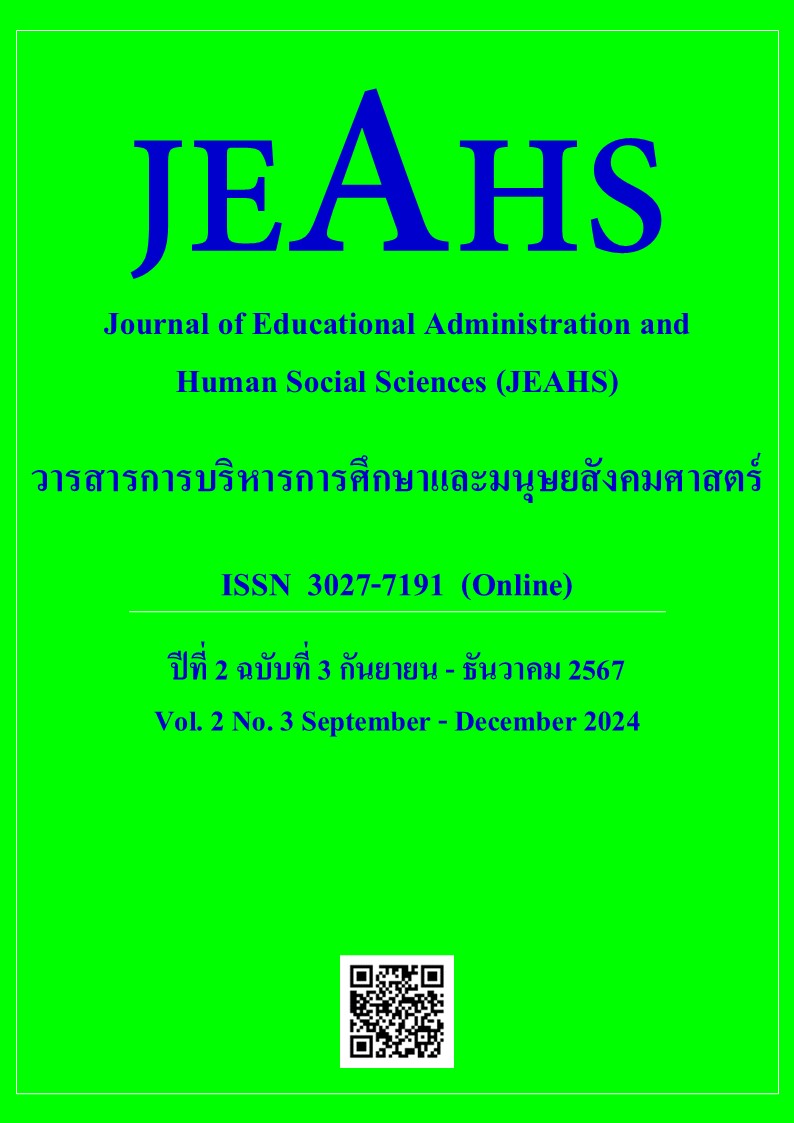STRATEGIC HUMAN RESOURCE MANAGEMENT IN THE DIGITAL SOCIETY ERA BASED ON THE FOUR DIVINE STATES OF MIND
Main Article Content
Abstract
This academic article aims to study strategic human resource management in the digital age by applying the four divine states of mind (Brahmavihra) to create an organizational culture that supports collaboration and promotes personnel efficiency. Applying the four divine states of mind (Brahmavihra) to strategic human resource management in the digital age, systematic planning and implementation to achieve set goals by analyzing the current situation and forecasting the future to determine the direction and guidelines for operations that are consistent with those goals can help organizations achieve their goals more effectively, especially in terms of building good relationships between executives and personnel, developing personnel potential, creating innovation, and adapting to changes in the digital age. In addition, guidelines for applying the four divine states of mind (Brahmavihra) in the context of various organizations are proposed to maximize benefits.
Article Details

This work is licensed under a Creative Commons Attribution-NonCommercial-NoDerivatives 4.0 International License.
บทความที่ส่งมาขอรับการตีพิมพ์ในวารสารวารสารการบริหารการศึกษาและมนุษยสังคมศาสตร์ จะต้องไม่เคยตีพิมพ์หรืออยู่ระหว่างการพิจารณาจากผู้ทรงคุณวุฒิเพื่อตีพิมพ์ในวารสารอื่น รวมทั้งผู้เขียนจะต้องคำนึงถึงจริยธรรมการวิจัย ไม่ละเมิดหรือคัดลอกผลงานของผู้อื่นมาเป็นของตนเอง ซึ่งทางวารสารได้กำหนดความซ้ำของผลงานด้วยโปรแกรม CopyCat เว็บ Thaijo ในระดับ ไม่เกิน 25%
ในกรณีที่ บทความวิจัยมีกระบวนการวิจัยเกี่ยวข้องกับมนุษย์ ผู้นิพนธ์จะต้องส่งหลักฐานการรับรองจริยธรรมการวิจัยในมนุษย์มาประกอบการลงตีพิมพ์ด้วยจึงจะได้รับการพิจารณาลงตีพิมพ์ในวารสาร
ผู้เขียนบทความจะต้องปฏิบัติตามหลักเกณฑ์การเสนอบทความเพื่อตีพิมพ์ในวารสารการบริหารการศึกษาและมนุษยสังคมศาสตร์ รวมทั้งระบบการอ้างอิงต้องเป็นไปตามหลักเกณฑ์ของวารสารการบริหารการศึกษาและมนุษยสังคมศาสตร์ โดยรวมทั้งทัศนะและความคิดเห็นที่ปรากฏในบทความในวารสารการบริหารการศึกษาและมนุษยสังคมศาสตร์ ถือเป็นความรับผิดชอบของผู้เขียนบทความนั้น และไม่ถือเป็นทัศนะและความรับผิดชอบของกองบรรณาธิการวารสารการบริหารการศึกษาและมนุษยสังคมศาสตร์ และวารสารการบริหารการศึกษาและมนุษยสังคมศาสตร์
References
กระทรวงศึกษาธิการ. (2546). คู่มือการบริหารสถานศึกษาขั้นพื้นฐานที่เป็นนิติบุคคล. กรุงเทพมหานคร: โรงพิมพ์องค์การรับส่งสินค้าและพัสดุภัณฑ์.
จักรกฤษณ์ โพดาพล. (2558). ผู้บริหารกับพรหมวิหารธรรม. แหล่งที่มา https://shorturl.asia/vBA3V สืบค้นเมื่อ 30 สิงหาคม 2567.
ณัฏฐพันธ์ เขจรนันทน์. (2545). การจัดการทรัพยากรมนุษย์. กรุงเทพมหานคร: ซีเอ็ดยูเคชั่น.
ณัฐวุฒิ พงศ์สิริ. (2563). HR การบริหารทรัพยากรมนุษย์ในยุคดิจิทัล. แหล่งที่มา https://www.khonatwork.com/post/digital-economy-digital-hr. สืบคนเมื่อ 30 สิงหาคม 2567.
ประคอง สุคนธจิตต์. (2562). ทรัพยากรมนุษย์ ยุค 4.0. กรุงเทพมหานคร: มหาวิทยาลัยเกริก.
ประภาพรรณ กัณทวงษ์ และนิศารัตน์ โชติเชย. (2565). การจัดการทรัพยากรมนุษย์ในการก้าวสู่ยุค Digital HR. วารสารวิทยาลัยบัณฑิตเอเชีย. 12(1). 12.
พระธรรมปิฎก (ป. อ. ปยุตฺโต). (2534). การศึกษากับการพัฒนาทรัพยากรมนษยุ์. กรุงเทพมหานคร: โรงพิมพ์การศาสนา.
พระพรหมคุณาภรณ์ (ป. อ. ปยุตโต). (2551). พจนานุกรมพุทธศาสตร์ฉบับประมวลธรรม. พิมพ์ครั้งที่ 16. กรุงเทพมหานคร: เอส.อาร์. พริ้นติ้งแมสโปรดักส์.
พระมหาปริญญา เตชปญฺโญ. (2564). การบริหารงานบุคคลในยุคดิจิทัล. วารสารการสอนสังคมศึกษา. 3(2). 185-193.
มณีรัตน์ ชัยยะ และเพ็ญศรี ฉิรินัง. (2566). การบริหารทรัพยากรมนุษย์ภายใต้การเปลี่ยนแปลงสู่ยุคดิจิทัล (Digital HR). Journal of Administrative and Management Innovation. 11(1). 104-113.
มหาวิทยาลัยธรรมกาย แคลิฟอร์เนีย. (2550). สูตรสำเร็จการพัฒนาตนเอง. ปทุมธานี: มหาวิทยาลัยธรรมกาย แคลิฟอร์เนีย.
สำนักงานคณะกรรมการการอุดมศึกษา. (2547). เอกสารการเรียนรู้การพัฒนาการบริหารสถาบันการศึกษา. กรุงเทพมหานคร: สำนักงานคณะกรรมการการอุดมศึกษา.
สำนักงานส่งเสริมและสนับสนุนวิชาการ 3. (2567). การจัดการเชิงกลยุทธ์. แหล่งที่มา https://shorturl.asia/WIGwF สืบคนเมื่อ 10 กันยายน 2567.
อุษณีย์ จิตตะปาโล และนุตประวีณ์ เลิศกาญจนวัติ. (2548). การบริหารงานบุคคล. กรุงเทพมหานคร: ศูนย์ส่งเสริมวิชาการ.
Quality The Story. (2566). การบริหารกำลังคนในยุค Digital HR 5.0. แหล่งที่มา https://shorturl.asia/HYzX1 สืบคนเมื่อ 30 สิงหาคม 2567.


